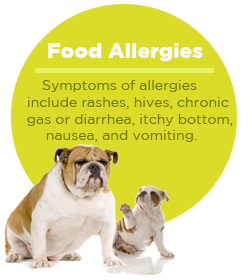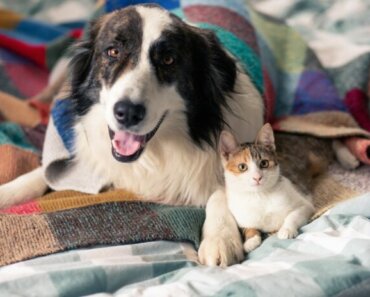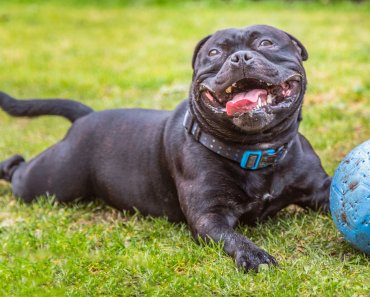
For original article click here
Knowing the Differences in Food Brands
 As you’re considering the type of dog food to purchase, there are some key things to understand about each before you decide which is right for your puppy.
As you’re considering the type of dog food to purchase, there are some key things to understand about each before you decide which is right for your puppy.
Kibble (dry food) – Dry food is typically the least expensive type. It’s also easy to store as it doesn’t require refrigeration. Additionally, dry food helps to keep your dog’s teeth healthy because chewing crunchy assists in removing tartar.
Canned (wet food) – Canned dog food has a long shelf life, making it convenient for many dog owners. It can be expensive, and also nutritionally incomplete. When considering canned dog food, be sure to look for labels that state “100% nutritionally complete” or “complete and balanced”. Some brands may contain too much water or indigestible proteins, which will pass through your dog offering little nutritional value.
Semi-Moist – This type of food often resembles “meaty” foods. It is commonly filled with preservatives and artificial flavors and colorings, offering little nutritional value. These types of foods are best used as an occasional treat.
Home Cooked – Making your dog’s food from scratch requires a lot of time, and can be costly, but many dog owners prefer to know exactly which ingredients are going into their dog’s food, and where those ingredients came from. Making your dog’s meals on your own provides the control that some dog owners prefer.
Raw – A raw diet consists of raw meat, raw bones, uncooked organs, fruits, and vegetables. Because of a dog’s short intestinal tract and strong stomach acids, they are typically able to handle a raw diet quite well. It can become time-consuming, pose a risk of dietary imbalances, and broken teeth. Before putting your dog on a raw diet, it’s recommended that you speak with your veterinarian first to better understand the potential health benefits for your dog.
Veterinary Diet – A veterinary diet is specially formulated to address specific health concerns in dogs with certain types of conditions. Only feed your dog this type of diet based upon the needs of your dog at the recommendation of your vet.
How to Select Food
A key thing to keep in mind as you consider the brands of dog foods available is that you want to focus on the first five ingredients, as they are the most important. Focus on finding high quality, digestible proteins, and try to avoid things like meat or poultry by-products, generic fat sources such as “animal fat”, and added sweeteners, artificial colors, flavors or preservatives.
Symptoms of Food Allergies
 Several signs and behaviors your dog could be exhibiting may be a sign of a food allergy. You’ll want to keep an eye out for ear inflammation, itching, or a dull coat. Pay attention to excessive licking or paw biting. Some dogs show symptoms similar to those in humans with food allergies, such as a rash on their skin, hives, chronic gas and/or diarrhea, an itchy bottom, nausea, and vomiting.
Several signs and behaviors your dog could be exhibiting may be a sign of a food allergy. You’ll want to keep an eye out for ear inflammation, itching, or a dull coat. Pay attention to excessive licking or paw biting. Some dogs show symptoms similar to those in humans with food allergies, such as a rash on their skin, hives, chronic gas and/or diarrhea, an itchy bottom, nausea, and vomiting.
The only way to really determine whether or not your dog has food allergies is by doing an elimination diet, whereby your vet will likely change your pup’s diet completely, introduce new foods, and then reintroduce the old foods in a few weeks to test his/her reaction to it.
There are common foods that cause food allergies in dogs including pork, rabbit, beef, chicken, fish, lamb, egg, corn, soy, wheat, and dairy. Many dogs are allergic to more than one ingredient, but they need to have a genetic predisposition to develop allergies for these to become a problem. In some animals, if they are still young enough, they may grow out of their food allergies.
How much do I feed my dog?
 To get started, refer to the feeding guide on your dog’s food. It’ll be a table that will recommend amounts based upon weight. Also, consider how much exercise your dog gets to determine if they need a little less, or a little more.
To get started, refer to the feeding guide on your dog’s food. It’ll be a table that will recommend amounts based upon weight. Also, consider how much exercise your dog gets to determine if they need a little less, or a little more.
Looking at your dog from the top, he/she should have an hourglass figure, meaning that their abdomen should be narrower than their chest and hips. Their chest should also be closer to the ground than their tummy, and their ribs should be easily felt with slight pressure.
Overfeeding your dog can lead to musculoskeletal problems, heart disease, skin disorders, oral disease, diabetes, arthritis and some types of cancer. Treats should only make up five percent or less of a dog’s daily food intake. Consider giving them in small pieces.
Foods to Avoid
There is quite a list of foods that you need to be absolutely sure your new pooch never gets their paws on. These foods can be dangerous or toxic to your pet, so be sure that they are not exposed to them:

In the event that your dog ingests anything on this list, consult emergency vet care immediately.
Creating Good Habits

Getting off on the right foot is essential for a healthy, happy relationship with your new puppy. Training is one of the best ways to establish a strong form of communication between you and your new pooch.
Training from Day One
Before you bring your new pup home, decide as a family what training language you will use, so that commands stay consistent. Training should begin immediately so that your new pooch knows what is allowed, what isn’t allowed, where their food and water dishes are, where they’ll go to the bathroom, what areas of the house are off limits, which are his/her toys and what is an absolute no. It’s important that your dog quickly understands which behaviors earn them rewards and positive attention. You’ll want to determine which types of behaviors your dog exhibits to get your attention are the types that will earn a reaction or reward from you.
Types of Home Training

You’re bound to get more than your fair share of advice when it comes to how to train your new fur baby. It can be overwhelming when looking at all the options with regard to how to train your puppy. There are several methods used to train dogs, and you may want to choose one, or a blend of these types of training:
Traditional Dominance Training
This type of training uses corrections like pulling on a leash or using a shock collar when trying to get a dog to obey a command. It encourages punishment or physical stimulus to gain the attention of the dog in an effort to control their behavior.
Koehler Method
The Koehler Method has been around for over 65 years, using the philosophy that “a dog acts on its right to choose its actions”. Essentially, the method teaches that a dog’s learned behavior are influenced by the expectation of reward, and then that behavior will most likely be repeated. This method also teaches that when the dog learns their actions are influenced by the anticipation of punishment, they will no longer exhibit those behaviors either. The Koehler Method puts heavy emphasis on off-leash training so that dog owners have control of their dog with a single command. The idea behind off-leash training considers the fact that dogs commonly get out of their collars, escape fences and pens, and run out of open doors. Dog owners using this method do make corrections, however, some of the original correction actions taught with this method are no longer utilized as they are considered unnecessary and inhumane.
Clicker Training
This method of training uses positive reinforcement like treats or toys, along with a “clicker” or small noisemaker to mark and reinforce the behavior. The clicker helps the dog identify the precise behavior that results in the treat or toy.
Electronic Training
The electronic method of dog training utilizes the use of shock collars or electric fences that distribute an electric shock to the dog. The intent is that the dog will receive a shock in response to negative behavior.
Model-Rival Training
Based on the principles of social learning, model-rival training utilizes a model, or rival for attention, who is demonstrating the desired behavior. The concept is that dogs were originally part of large social groups and can learn observationally. Within this method, the dog being trained is rivaling for the attention of the trainer, and will model the desired behavior that the rival dog is exhibiting.
Scientific Training
This method utilizes both positive and negative reinforcement, the idea being that you work “with” the dog, rather than just commanding them. The dog is taught which behaviors are desired based upon rewards, but also with negative reinforcement, for example taking away a toy the dog expected to get because he/she didn’t wait for you to throw it first before going after it in your hand. This method teaches the dog that unwanted behavior doesn’t work.
Positive Reinforcement or Motivational Training
This style of training utilizes no negative reinforcement. Owners do not correct for poor behavior but instead reward for positive behavior. The school of thought with this method is that poor behavior simply be ignored and that dogs will learn to only exhibit the behavior that elicits reward.
Science is proving that punishment is not as effective a learning system as are rewards. Punishing your dog often confuses them, as often times they don’t know or understand what it is they’ve done wrong. A dog who appears to be responding to punishments is likely afraid of their owner, and can start to exhibit aggressive behaviors in situations they don’t like.
A positive reinforcement method that rewards dogs for desired behavior has proven to be more effective, and one that can be utilized by the whole family, rather than just the strongest person in the home. You can combine rewards and positive consequences with positive behavior so that your dog quickly learns the desired way to behave. When you train your dog with rewards, their joy-filled personality is more fully realized.
Selecting the Right Trainer

Only you can decide on the right trainer for you and your dog. The most important thing about dog training is to first determine what it is you want to get out of dog training. Is it basic obedience, or are you looking to go further?
You also need to find a trainer who has the same philosophy and ethics about dog training that you do. If your trainer believes in methods that make you uncomfortable you will be nervous, and your dog will sense that, making the method ineffective. It’s important that you are a large part of the training process, and that the trainer is working with you just as much as the dog.
Ask around to find out about trainers in your area whom your trusted friends and neighbors have worked with. Make sure that your trainer is certified, and ask for referrals from their current or previous clients.

 At some point, you will feel ready to start introducing your dog to other dogs.
At some point, you will feel ready to start introducing your dog to other dogs.
It’s nice for him/her to find some playmates, and gives them another outlet for exercise. Dog parks can be a great opportunity for your pooch to run freely in a controlled environment.
Start socializing your dog between 3 and 12 weeks of age.

























